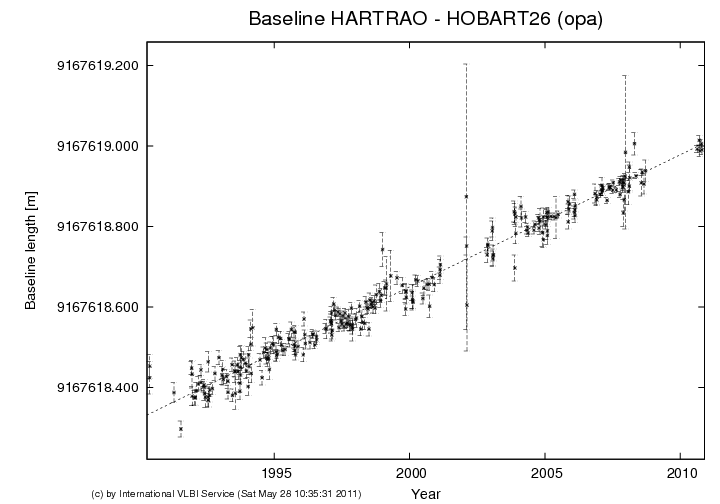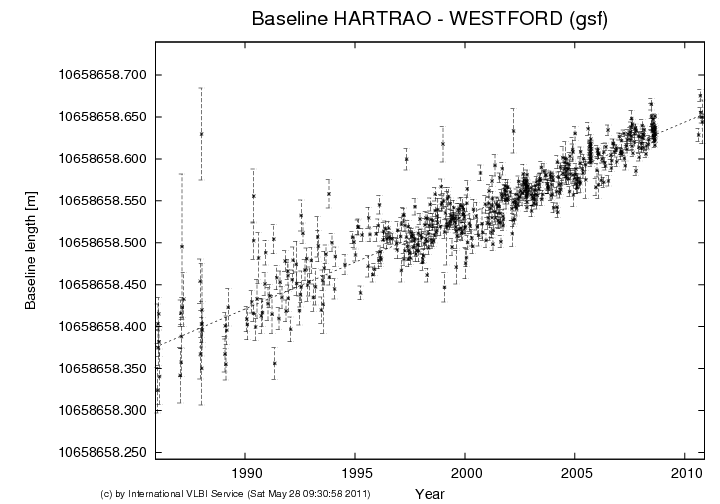
HartRAO Home >
news >
Geodetic VLBI Results after 26m Telescope Bearing Replacement 2011-05-28
Geodetic VLBI Results after 26m Telescope Bearing Replacement 2011-05-28
A major motivation in repairing
and returning to service the 26m radio telescope at Hartebeesthoek after the
main bearing failure in 2008 October was its role in providing regular
precise absolute position determination. It did this by operating with
other radio telescopes in a global network carrying out geodetic Very Long
Baseline Interferometry (VLBI), using distant quasars as fixed reference
points in space. These experiments began in 1986 as part of the NASA Crustal Dynamics Project
for measuring plate tectonic motion, and provided a 22 year time series of
data.
The HartRAO telescope was the only operational radio telescope in Africa with geodetic VLBI
capability. Its abolutely referenced position provided an anchor for the
co-located NASA MOBLAS-6 Satellite Laser Ranging System (SLR), Global
Navigation Satellite System (GNSS) receivers and DORIS satellite orbit
determination system. This made HartRAO a key fiducial station for the
International Terrestrial Reference Frame (ITRF), and it had also become the
reference point for the survey system of South Africa.
Therefore a critical question was how accurately the repaired telescope
had been returned to its original position, in order to continue the
position time series without a discontinuity. Major mechanical repairs on
some other radio telescopes are known to have shifted their positions and
introduced offsets in their data time series.
The first post-repair VLBI was for geodetic purposes, carried out on 2010
August 11. Further geodetic VLBI's have been carried out at typically
weekly intervals since then. The results of these are now coming in from
the six data processing centres of the International VLBI Service for
Astrometry and Geodesy (IVS).
Graphs of the baseline lengths between the HartRAO 26m telescope and
representative radio telescopes on other continents are shown below,
courtesy of the IVS
Analysis Coordinator. The baseline lengths change steadily with time
owing to the steady movement of the Earth's tectonic plates, and sometimes
abruptly when the position of a telescope is shifted by a nearby earthquake
at a boundary between plates. An example of the latter is shown below, a
consequence of the magnitude 8.8
earthquake in Chile on 2010 February 27.
The graphs reproduced below and data analyses from all the data centres and show that there has been no
need to introduce a discontinuity (or "episodic motion" in geodetic VLBI
wording) for the HartRAO 26m telescope position after the repair.

Left click on image for large version.
Graph of baseline length between the HartRAO 26m radio telescope and Hobart 26m
radio telescope in Tasmania.
The data gap between 2008 October and 2010 August was
caused by the bearing failure of the HartRAO 26m telescope.

Left click on image for large version.
Graph of baseline length between the HartRAO 26m radio telescope and the Seshan
25m radio telescope in China.

Left click on image for large version.
Graph of baseline length between the HartRAO 26m telescope and the 6m TIGO telescope near
Concepcion in Chile. The 2010 earthquake in Chile epicentre was about 115
km distant and changed the baseline from HartRAO to TIGO by
1.864 +/- 0.009 m. Total displacement at TIGO was 3.19m.

Left click on image for large version.
Graph of baseline length between HartRAO 26m radio telescope and the Tsukuba
32m radio telescope in
Japan.

Left click on image for large version.
Graph of baseline length between the HartRAO 26m radio telescope and the
Westford 18m radio telescope in Massachusetts, United States of America.

Left click on image for large version.
Graph of the baseline length between the HartRAO 26m radio telescope and the
Wetzell 20m radio telescope in Germany.






